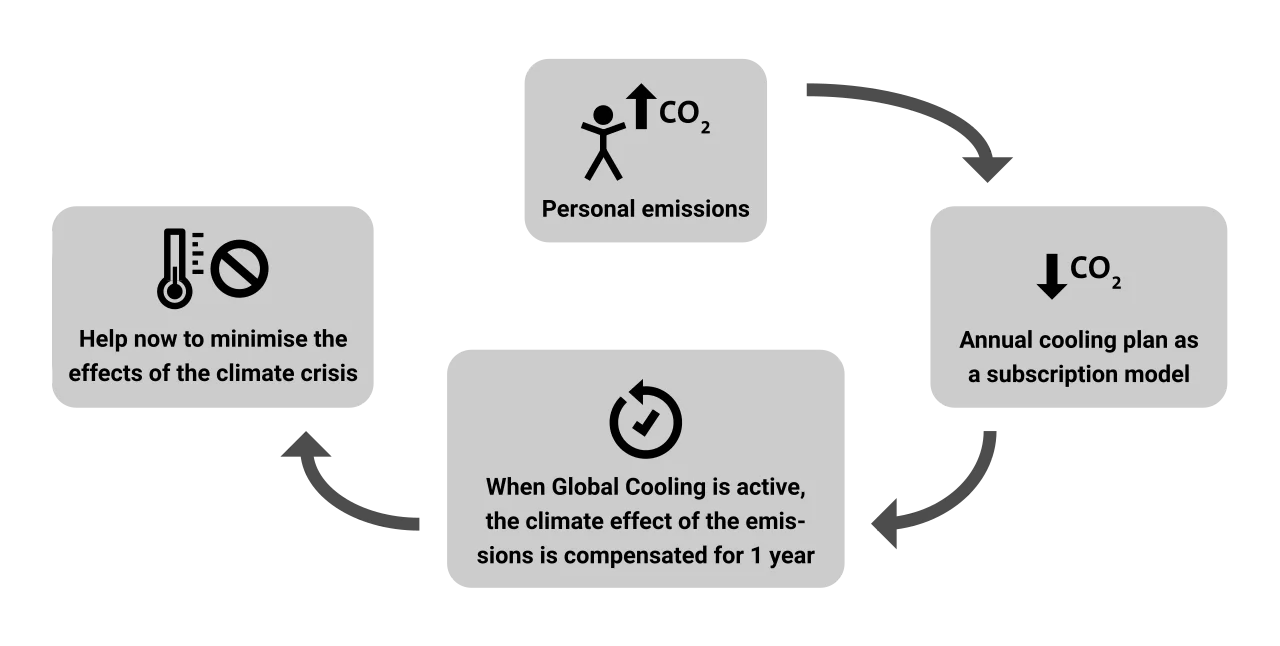
Global Cooling
The base of the new carbon sink economy
CO2 emissions cause a global warming effect for thousands to millions of years. To compensate such emissions completely, the same amount of CO2 must be extracted from the atmosphere and stored as a carbon sink (C-sink) for an equally long time. However, to avoid accelerating climate change, we need climate action now.
A carbon sink that persists only for 10 years contributes to climate change mitigation and has a global cooling effect during these 10 years as large and efficient as a carbon sink that will persist for a thousand years. The majority of carbon sinks do not persist for thousands of years and are therefore not considered as long term. Therefore we must not solely focus on long-term C-sinks. Temporary carbon sinks are as essential to save the climate as long-term carbon sinks.
The present certification method allows a correct accounting of short-, mid-, and long-term carbon sinks and their combination in C-sink portfolios.
It can be expected that global cooling services and not CO2 offsets will become the base of the new carbon sink economy.
Global Cooling considers the cooling effect of C-Sinks and integrates them into an overall system of reliable climate actions.

Natalie Steiner
With a sustainable lifestyle, we can further reduce our climate emissions. With Global Cooling, a system has now been developed with which I can reliably compensate my previous and remaining emissions. Of course, this also works for companies, which can choose the cooling plan according to their needs.
A carbon sink (C-sink) is defined as carbon that has been removed from the atmosphere and is stored in an environmental compartment other than the atmosphere in a controlled manner. The most important C-Sinks are found in soils, plants, built materials and bodies of water. A C-sink is the physical unit of stored carbon that is certified and registered. Any C-sink provides a global cooling service that counterbalances the climate warming effect of emissions of the same amount of CO2e for as long as the C-sink persists.
A global cooling service is a measured and certified effect on the climate that a C-sink has over a defined period of time. Global cooling services can only be traded by endorsed Global Cooling Traders.
Just calculate your emissions and compensate your climate effect with Global Cooling Services.
With Global Cooling Services, you compensate for the climate effect of your emissions for one year or, if required, long-term.

- Global Cooling is calculated on annual bases.
- Global Cooling Services are time dependent. The date of CO2e emission and CO2e removal are decisive parameters for the calculation of global warming and global cooling effects.
- All carbon emitted must be compensated by at least the same amount of carbon sequestered in a C-sink during the annual reference time. We always compensate carbon with carbon as all fossil carbon that has been emitted must be returned to the terrestrial stores. Ten tons of CO2e emitted means at least 10 tons of CO2e sequestered, no matter when the emission happened and when the sink was built. It is always and only carbon that is traded.
- The global warming effect of a CO2e emission must at least be met by a same-sized cooling effect during the reference time. An emission can only be compensated by a sink if, for each individual year, the global cooling of the sink is at least as large as the global warming of the emission. The global warming of the emission and the global cooling of the sink must thus always be calculated and compared. If the cooling is smaller than the warming, although the emitted and removed carbon quantities are equal, more sink capacity must be made available. The latter is the case if an old sink is used to compensate for a recent emission. The sink must then contain more carbon than was emitted.
- The cost of annual global cooling services comprises the direct cooling effect of the C-sink and the preservation of the C-sink. Preservation of an additional C-sink maintains the indirect, natural cooling (natural distribution of atmospheric CO2 to the biosphere and oceans).
- A carbon sink can only be considered a carbon sink when it is additional to the natural carbon sinks. A forest or marshland that exists for many decades or centuries is a natural carbon sink that is an essential part of the natural carbon cycle upholding the reduction of emitted CO2 in the atmosphere. As an additional carbon sink, for example, the planting of a new forest on barren land or the pyrolysis of annual crop residues that would not have been produced without human intervention can be considered.
The first step is to calculate the amount of CO2e emitted which has accumulated over several years and is causing a warming effect. Even though CO2 has been partly absorbed by the planetary carbon pools over the years, the total emissions have to be compensated. This must be done because when the concentration of CO2 in the atmosphere is reduced, carbon from carbon pools flows back into the atmosphere.
Once your personal emissions have been calculated, you can decide from which year you want to compensate for your climate effect. You can either compensate for the emissions of the current year or retroactively neutralise the climate effect of the last few years or even your entire life.
The difference to traditional compensation is that Global Cooling allows you to compensate your climate effect annually and not just long-term. This means that the costs are significantly lower and private individuals, but also companies, can compensate for their climate effect with a realistic budget. Global Cooling also opens up a new market for short and medium-term C-sinks. All types of carbon sinks are reliably integrated.

The users of Global Cooling Services have 3 options:


Adèle Thorens Goumaz – President of bio.inspecta AG - Former member of Swiss Parliament
Together with the team at Carbon Standards, we quantified my personal emissions. When calculating the emissions, we took into account that a sustainable lifestyle is important to my family. I chose my cooling plan based on this.
Even if we are able to gradually reduce our climate emissions further over the next few years, we also need reliable carbon sinks in order to achieve our climate targets. It is important to have a new opportunity with Global Cooling Services to participate more actively in climate protection as a private individual and compensate my emissions.
Carbon Standards and Ithaka Institute have developed the Global Cooling Services and are pleased to present them to you in a pilot phase. You are invited to get one of a maximum of 99 pilot certificates.
Please register your interest
- Private individuals
- Companies
- Organizations
Get in touch with us: Form Participant
Following the successful implementation of the pilot phase, the service will be handed over to accredited Global Cooling Traders in 2024.
Our Global Cooling Partnership programs are relevant to carbon credit suppliers and future Global Cooling Traders. Simply join our new partnership programs now and be part of our common Global Cooling journey in the pilot phase. As a Global Cooling Partner, you will be published on our website.
Please register your interest
- C-Sink supplier
- Trader (implement your first clients in the pilot phase)
Planetary Carbon Recycling - Global Cooling with Temporary C-Sinks
by Hans-Peter Schmidt and Nikolas Hagemann
Carbon from biomass and carbon that is recovered and synthesized directly from the atmosphere and oceans will become the future basis of the global economy. Carbon must be constantly recycled instead of mined fossil deposits. As long as biogenic and recycled carbon remains in forests, swamps, and materials such as houses, roads, batteries, cars, furniture, wind turbines, skis, and T-shirts, it will act as a temporary carbon sink. Regardless of the lifespan of a carbon sink, as long as the carbon sinks are continuously renewed and the amount of carbon in circulation remains the same, the temporary carbon sinks have the same global cooling effect as permanent geological carbon sinks.
We are yet to publish our new standard. Register now for our Newsletter, we will keep you informed.
Calculate your Carbon Footprint, based on Global Cooling principles.
Find a list of IT Tools applicable to the Global Cooling Standard here:
In this section you will find further information and required documents:
If you would like to have Carbon Standards review potential modifications or amendments to the standard, please review the following:
Please refer to our Design Manual for the correct use of the label.

Contact person
 Ueli Steiner
Ueli Steiner



